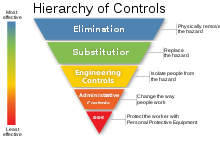Topic 1: Industrial Ventilation
Topic 2: Engineering Controls
Engineering controls are an important part of the hierarchy of controls. When it is not possible to eliminate the hazard or substitute for a less toxic substance, engineering controls are the next preferred way to protect workers. They come above administrative controls and personal protective equipment, because effectiveness of engineering controls is generally independent of the worker. They also remove the hazard at the source, before the worker is exposed. [1]

Types of Engineerings Controls:
- Process control
- Isolation of process
- Ventilation - local and general
Process control involves changing the way the process is done to better protect the work. For example, a dip tank that uses a volatile chemical may be may be run at lower temperature to reduce emissions. An open process may be changed to a closed process so that the worker does not come into contact with the hazardous chemical.
Process isolation involves separating the process from the worker, by creating a physical boundary around the worker and/or around the process. For example, a tightly sealed booth enclosing a process or the cab on a tractor that is sealed and air-conditioned to protect the driver. Other examples of process isolation include machine guarding, cages around robots, lockout-tagout during repairs, etc. Other types of process controls are sticky mats,
Ventilation controls may include both local exhaust ventilation and general or room ventilation. General ventilation is primarily used to control heat, odors, and nuisance contaminants. It works by diluting the contaminant.
Local exhaust ventilation is the most effective way to protect workers from contaminants at the source of their emission. [3] Examples of LEV useful for specific applications include the following: Glovebox Fume hood Biosafety cabinet Vented balance safety enclosure
- ^ 978-1-935082-15-6
- ^ https://www.ccohs.ca/oshanswers/hsprograms/hazard_control.html
- ^ ACGIH. Industrial Ventilation, A Manual of Recommended Practice for Design. Cincinnati, Ohio. 2016
